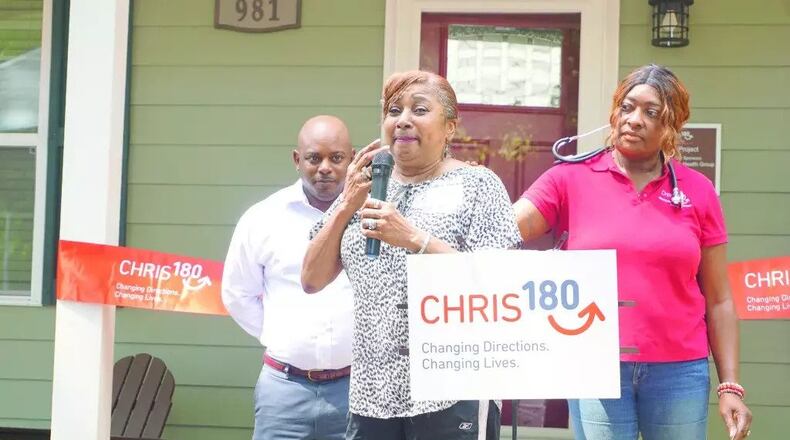Think about the term “intergenerational living” and what comes up is likely this: grandma and grandpa are in a small apartment over the garage. Mom and dad have their master bedroom on the main floor. The kids sleep upstairs.
While that model is still around-and in fact is making a comeback after years of emphasis on independent living-some more adventurous methods of putting the generations together under one roof are showing results in Georgia and elsewhere.
One of the most notable is FILE – or the Flint Intergenerational Living Experience – coordinated by officials at the University of Michigan at Flint. Under the program, four graduate students-two in physical therapy and two in occupational therapy-moved into a senior housing complex. The students lived rent-free in return for performing service hours.
The program achieved several goals, said Jennifer Blackwood, associate professor and head of the occupational therapy department. Among them was creating a food pantry project and developing a program where grief counselors came in to help those who had lost a neighbor.
Some hitches also developed, including COVID making it tough for the students to complete their service hours.
For graduate student Elizabeth Mansfield, the experience became very personal. “I’ll spot a group of (seniors) in the TV room and stop to chat. Sometimes I’ll hang out and talk for hours,” she said. “I’ll talk about my school day and what’s going on in my life.
”The aim of the program: to expose students to experiences with older adults that would steer them toward a career in geriatrics.
Closer to home, a program at Mercer University in Macon is structured similarly but has had broader goals.
Two 2019 graduates worked out the approach as part of a Service Scholar project. They moved into a senior center. The aim was to ease loneliness among older adults at the complex, reconnecting them with the larger world and helping them feel less isolated by planning activities and helping them with tasks. In return, the students paid no rent.
The benefits turned out to be substantial.
”The seniors loved being with young people who are interesting, and the seniors feel a little supportive, protective even,” said Dr. Mary Alice Morgan, an English professor and co-chair of the English Department who supervised the program for a time.
She says the older adults fed off the energy of the students and liked the conversational topics the younger people brought. They also picked up skills in computer literacy and other areas. The seniors gave back as well, one of them tutoring a student in Spanish.
On the reverse side, she said while the program ran smoothly for its first two years, the third year saw some problems develop with orientation, which needed to be “more robust” and communication between the senior center and the students in the program was sometimes disjointed.
While the Mercer program and its aims were planned well in advance, the beginning of a similar program in Atlanta arose more spontaneously.
“We encountered an elderly woman on the Westside who was living in a shed on her property, her home having been demolished recently,” said Kathy Colbenson, President and CEO of CHRIS 180, an agency dedicated to working with children and families experiencing trauma.
The idea arose: why not build a home for Deborah Glover, the elderly woman, as part of an experiment where she’d live beside young moms with babies and toddlers needing a place to stay? Glover would provide guidance and advice to the moms and they would provide her with company and daily living support.
Credit: CHRIS 180
Credit: CHRIS 180
It’s worked out well, said Colbenson. While donations paid for the home, the non-profit is unsure whether the program will continue. Funding is an issue.
Demographers say the overall trend of increasing intergenerational living is backed up by the numbers.
The Pew Research Center did a study showing multigenerational living of all forms (three or more generations under the same roof has quadrupled in the past 50 years). Closer to home, another study showed the number of multigenerational homes in Georgia rose 8% between 2014 and 2018.
“There’s an increasing awareness of-I guess the scholarly term would be ‘interdependence,’” said Dr. Heidi Ewen, a gerontologist and associate professor at the University of Indianapolis who focuses on housing and environment. “The focus of our society and western society has been on independence, which is a fallacy.”
In another iteration, Ewen says she saw an increasing house-sharing trend beginning in the late 1990s around college campuses.
“There was a woman who tried to start this in Athens. She had a huge home, the kids were gone, and it was expensive to heat a big house. She also wanted to find someone who could run errands and whatnot,” Ewen said.
A more formalized matching strategy has developed in some areas where older adults share a home with students who might get a break on what they pay in return for running errands and doing chores. While some students might just want “a place to study and sleep,” says Ewen, more of an exchange can sometimes develop.
Such give-and-take is what Washington DC-based Generations United is aiming for. The non-profit promotes a variety of intergenerational programs.
Intergenerational home sharing is one of those efforts, says Executive Director Donna Butts, and it can take one of several forms, from an older adult renting out space to a student to mixed housing as opposed to senior-only communities.
She says such approaches give seniors purpose and a sense of optimism “and hope to know that life goes on.”
She says that in senior-only spaces conversation tends to center around the three Ps-”pain, pills and passing” and a multigenerational approach improves conversations and relationships.
Katie Perumbeti, the Lifelong Communities Coordinator at the Atlanta Regional Commission, also senses a move away from senior-only communities.
She says past data-gathering on where people want to be or move to “when you break it out by age, older age brackets want to stay where they are.”
“People want their community,” she says.
This article was written with the support of a journalism fellowship from The Gerontological Society of America, The Journalists Network on Generations, and The Silver Century Foundation.
Credit: Rough Draft Atlanta
Credit: Rough Draft Atlanta
MEET OUR PARTNER
Today’s story comes from our partner, Rough Draft Atlanta. Rough Draft publishes Reporter Newspapers, community newspapers in Brookhaven, Buckhead, Dunwoody, and Sandy Springs. Visit them online at RoughDraftAtlanta.com or on Instagram @Reporter_News.
If you have any feedback or questions about our partnerships, you can contact Senior Manager of Partnerships Nicole Williams via email at nicole.williams@ajc.com.
About the Author
The Latest
Featured





